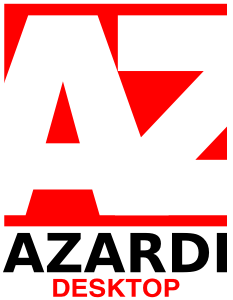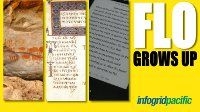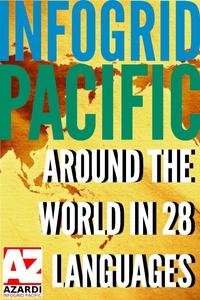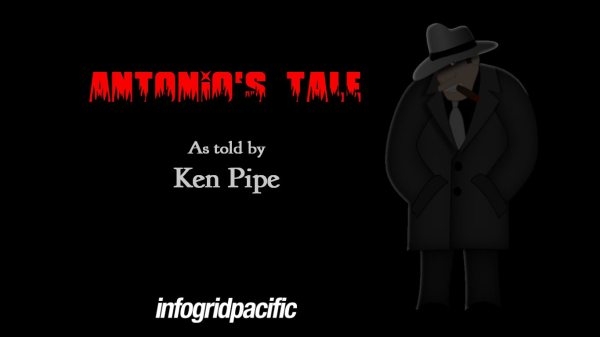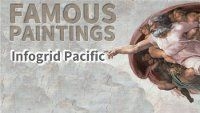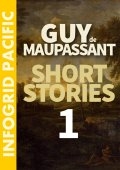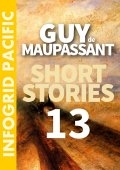Is ePub3 Suitable for Education Content?
25 May 2013
Infogrid Pacific is a digital content solutions provider for publishers. We have a particular interest in education content in general, but in particular the problems of delivering digital education content in the developing world in multiple languages and to the widest range of platforms and devices.
This post is about Digital Content Production and delivery for education, learning and training. It specifically discusses the problems of using ePub3 as the delivery container for ePub3 content and the state of play of reading systems.
Infogrid Pacific is a digital content solutions provider for publishers. We have a particular interest in education content in general, but in particular the problems of delivering digital education content in the developing world in multiple languages and to the widest range of platforms and devices.
The demand, perhaps even need, for education content to be available for digital delivery is rising around the world. There are a number of problems with the delivery of digital education content that have not been addressed let-alone solved. Assuming that ePub3 is the package, the biggest problem is the available reading systems and platforms.
The ePub3 Reading Systems
AZARDI was the first ePub3 reading system to market released just a month after the first specification was finalized. It was also the first fixed-layout ePub3 reading system and the first with SMIL audio overlays. We were on a mission and that mission was delivering education digital content.
After 18 months it remains the only usable specification compliant reader available for education content today. It is designed for the secure delivery of content to all desktops, devices and browsers which makes it very different from other systems.
The IDPF Readium ePub3 browser plug-in reading system is very much focused on trade and manga (comics). There has not been a lot of thought put into the generalization of the reading system for education, learning or training content. To be reasonable it is a demonstration system from the IDPF currently locked to browsers and Webkit, but you would think the exemplar system would be better. It largely mimics the limitations of iBooks presentation options.
The third ePub3 reading system is Apple's iBooks. This reading system is the flashiest in what it does, but is the most shallow possible interpretation of the ePub3 specification possible and still get away with calling it ePub3.
ePub3 and Education Content
It is a reasonable assumption that education content publishers should be able to look to ePub3 as the delivery format for learning content. It was released in 2011 and at the specification level, especially at the very competent fixed layout specification level, ePub3 shouts "use me" for education content.
You can theoretically mix reflowable and fixed layout, spreads and non-spreads, include interactivity with audio and video. Pretty much all you could ask for to create compelling and usable content for learning engagement. Theoretically.
Reading system presentation flexibility is the key. With digital content production and presentation there are three inextricable links:
- The content
- The container (Viewport size and aspect ratio)
- The Reading system ePub3 feature support
The required flexibility is contained in the fixed-layout specification. If the specification is implemented in reading systems correctly virtually any screen size or aspect ratio can be accommodated during content production. This is illustrated in the post AZARDI Making an ePub3 Difference.
When a reading system nit-picks these vital major presentation features the ability to deliver education content as ePub3 is instantly destroyed. The alternative is to produce multiple versions of content for the limitations or strengths of different reading systems. Education content publishers should be ready for this as a ground reality.
The two reading systems other than AZARDI are focused on trade genres rather than the full digital content continuum that exists. They also significantly control the viewport and inevitably the content must be made to fit the viewport.
How We Use It For Education Content
Our general approach to textbooks that are being distributed with AZARDI is to create the oxymoronic reflowable fixed-layout ePub3, power up the interactive navigation, and insert fixed layout sections when required primarily for interactive exercises.
The fixed layout properties typically look like this:
<meta property="rendition:layout">reflowable</meta>
<meta property="rendition:orientation">auto</meta>
<meta property="rendition:spread">auto</meta>
That makes the core book work exactly like a reflowable ePub. Fixed layout sections are then inserted using spine properties. Alternatively if we want to enforce the orientation of a book, to portrait for example we may use:
<meta property="rendition:layout">reflowable</meta>
<meta property="rendition:orientation">portrait</meta>
<meta property="rendition:spread">none</meta>
We never use "page-flipping" spreads. It increases production costs and it is easier and better to use a landscape fixed layout page. The gutter shadow delivers very little.
It is essential to be able to decide as an education content/course designer whether content should be fixed or reflowable, and if reflowable, paginated or scrolling.
The required options are available in the ePub3 fixed layout specification except whether the reflowable content is paginated or scrolling. This is a device option but probably should be a configuration option.
We can now choose to have interactive fixed layout or exploration sections, pop-up interactions or just about anything else needed to create learning optimized and compelling content engagement experiences. That is a lot of fixed layout spine properties, but it is not particularly difficult. It certainly takes longer to design good content interactions than handle the technicalities of ePub3 fixed layout spine properties.
How Readium and iBooks fail Education Content
The most important issue is content presentation in reflowable and fixed layout mode. Both Readium and iBooks fail big time but with different failure patterns.
iBooks
IBooks does not allow reflowable and fixed layout mixed content. It also loads pages in pairs as a subset of the spread page loading. This significantly impairs performance of true landscape or portrait locked page loading.
IBooks probably does this because they don't want ePub3 competing with their channel locked iPublish book format which does have widgets and allows reflowable content mixed with fixed layout content. It is probably a deliberate marketing thing, but that is of course purely conjecture!
Readium
Readium does not handle spine fixed layout properties. You can have spreads or single pages configured from its Settings, but it does not take notice of spine properties especially redition-spread-none. It spreads away on everything which makes screen optimized content too small to read.
Readium also loads everything at book opening time. If you have any interactivity such as a CSS animation on a page-entry it is all fired at book loading time and the interactive value is destroyed. When you get to the page. The animation is gone. We use a lot of on page entry CSS animation for instructions and lessons as it significantly reduces interface learning time and creates instant engagement.
Our experience with education content to-date shows the ability to go seamlessly from a reflowable page to a fixed-layout landscape no-spread page is one of the most important requirements.
How AZARDI Succeeds for education
Quite simply by being the only ePub3 reading system that has implemented the fixed layout specification correctly, works across all platforms, and has implemented the serious digital content presentation features needed for education digital content.
You can use all the ePub3 fixed layout spine properties in AZARDI and they will do exactly what the specification says AND more.
That means reflowable paginated or scrolling; and fixed layout with a lot of presentation options, options which should be available in any reading system.
Of course most people's engagement with AZARDI is with the free desktop versions for Linux, Mac and Windows and their trade books. The same features are available on the Android and iOS mobile versions.
IGP Test Books
In our small corner of the digital content continuum we have create the IGP test/demonstration book collection. These are designed to exploit and test the ePub3 specification in a comprehensive manner across a wide range of platforms. The IGP ePub3 demonstration/test books may or may not work on the other two "ePub3 reading systems", iBooks and Readium. That is because the books are created against the ePub3 specification not reading system limitations. We have that luxury because we have both IGP:Digital Publisher to create the content and AZARDI to deliver it.
There is a small collection of limited use ePub3 test books on the IDPF site. Their dysfunctional nature may be OK for developers (we found them largely unusable when developing AZARDI), we had to grow our own test books for real ePub3 reading system feature development. Especially fixed layout. A small subset of the 40 Fixed Layout development test books we created is available here.
There has to be some serious test books that address the non-proprietary specifics of ePub3 AND push digital content forward. These should be accessible to non-technical people to allow them to easily understand the values inherent in ePub3.
In general ePub3 books are created against the reduced features of iBooks. Therefore there are no demonstration or test books available outside of the iBooks feature subset. This is not rocket science. People build against what they know and what they have.
Here are some of our ePub3 testbooks with a quick overview of why they exist. All books can be downloaded from our AZARDI Resources Page here.
Fixed Layout Grows Up
This book is the most literal interpretation of the ePub3 fixed layout specification available. It will not work on Readium or iBooks because it contains fixed layout features they don't even approach.
This is our development exemplar showing very advanced fixed layout features like:
- Reflowable and fixed layout
- Standard spreads with left, center and right alignment
- Locked landscape and portrait fixed layouts
- Asymmetrical Spreads
- Spreads with different aspect ratios
And lots more. You probably have to be familiar with the specification to really understand what is going on. Take a look, but make sure you use AZARDI.
A Christmas Carol SMIL
This was the first audio overlay book in ePub3 and was only playable in AZARDI a year ago. It has word, phrase, sentence and paragraph syncronization/highlighting. IBooks only supports SMIL in fixed layout so this doesn't work there. It works in Readium as continuous reading, but they don't have the ability to click on a section of text and have it replayed or played forward from that point. This is an essential feature with learning content and for accessibility.
Importantly we have IGP:Digital Publisher with a full set of tools available to produce sophisticated SMIL books and have produced many adult and children books in many languages.
Around the World in 28 Languages
The ADE ePub2 reader made handling many languages very difficult with its insanely limited default character set. Every Amazon Mobi did considerably better. If your book had a little Greek or Arabic epigraph, you were probably driven to using images. Right to left (RTL) text flow and page progression is also important.
EPub3 has significantly freed the digital book world from the Latin alphabet. A demonstration/test book which allows the comprehensive evaluation of many languages, especially non-alphabet languages was seen as important. Alphabets, scripts and ideographic languages are all presented in completeness.
This demonstration book exploits the HTML/5 multilanguage support features of modern browser engines rather than anything from the IDPF. All reading systems handle all languages well. We are now happily creating textbooks in Hindi, Marathi and Chinese.
Antonio's Tale
Antonio's Tale is fixed-layout landscape and contains user mixable audio, some embedded fonts and lots of CSS animation. It also has seven pages which are linear="no" in the spine. Readium ignores spine properties apparently. So this does work on Readium but you have to use setting to set it to single page, and you don't get the story in the book because of wrong navigation.
It displays in iBooks, but because you are only allowed one audio file at a time in the ebook reader you don't get to play with the audio. While that may be a reasonable limitation on a tablet, but shouldn't set the standard for the format.
This book also significantly highlights the image animation limitations of iBooks (although that was a disappointment, not an objective). It cannot handle the aggressive CSS horizontal animations at all. All files are within the 2Mpx specification, but we really want to make them move. Don't bother. Interestingly AZARDI for Android handles these CSS animations relatively easily as does Readium of course.
Antonio's Tale will only work properly on AZARDI which allows agressive CSS animation and multiple audio remixing in ePub3 files.
You can read The Story Behind Antonio's Tale here.
Famous Paintings
This was our first ePub3 fixed-layout book with asymmetrical spreads. It was made as an experiment using asymmetrical spreads for navigation through a subject. It demonstrates fixed layout which uses (fully within the specification) asymmetrical spread panels. No other reading system addresses this even though it is relatively trivial to support AND incredibly useful with education content because it can significantly simplify navigation. This feature is also demonstrated in FLO Grows Up.
A symmetrical spread is like a print book, not a new invention and relatively useless if you have landscape orientation locked available. Even dumb ol' Kindle developers could work this out. This book will only work on AZARDI because everyone else in the world can only think of two panels side-by-side as a print book imitation limitation.
There is more information on the nitty-gritty of Making Famous Paintings here.
Widget World
This test/demonstration book shows how easy it is to implement iPublish-like widget features with Javascript in ePub3. We haven't applied any DRM or protection so the simple methods using the AZARDI Interactive Engine are all there to be seen.
It includes our nine standard Question and Answer patterns and a number of presentation widgets to make fixed layout work on smaller devices.
This is fixed layout locked into landscape orientation. Because we have not done anything with orientation or rendition this works on the three reading systems.
This book has similar widget features to those available in mobile Apps and Apples' iPublish application. These features primarily exist to compensate for the fact that the Readium and iBooks reading systems (and presumably systems to come) do not allow mixed reflowabable and fixed layout section sequencing with the correct presentation.
Guy de Maupassant Series
This is a set of test books we used to test the new remix feature in IGP:Digital Publisher. Besides ePub3 there are Mobi and PDF versions all produced simultaneously.
The interesting ePub3 feature here is pagebreaks. The ePub3 books uses the ePub3 pagebreak property matching the Paperback print edition. When converting textbooks to ePub3 we use this feature always to make it easy to have both digital editions and print editions in the classroom. If the teacher says "turn to page 124" everyone can get there easily.
Readium has reasonable support for the pagebreak property. iBooks has no support at all. This is a very strong ePub3 feature for many content genres.
You can view and download the 80 Guy de Maupassant book/formats here.
And In Conclusion
The Question "Is ePub3 suitable for Education Content". The answer is yes if you match your production to specific ePub3 reading systems. The answer is no if you are looking at iBooks or are hoping one ePub3 format will be able to be used on all reading systems (now and into the future).
The pressure is on education content publishers to go digital. The real answer is don't let your content be locked into a delivery format package by having it produced directly from InDesign, a custom App delivery environment or a conversion house. You get one package once and have nowhere to go. Education content needs to be a lot more agile than this. It needs to be able to be dynamically remixed to make new courses, enhanced over time and delivered in multiple formats and multiple platforms, including good old print PDF.
EPub3 is emerging as irrelevant to real education digital content strategies except at the packaging baseline at the OPF and TOC.html level. Think of it as just one format option. Don't produce only for ePub3. You need to make sure your content is digitized in trustworthy HTML5 so you can instantly adapt to business demands.
Choose a neutral production system that has the capability to generate any required format package including ePub3. Of course we suggest IGP:Digital Publisher, but we would!
Posted by Richard Pipe
Start a real digital content strategy with
IGP:Digital Publisher
The complete digital publishing content management and production solution.
Available as for Small and Medium publisher:
IGP:Digital Publisher is also available as a full site license purchase.
Contact us for more information...
Use one master XHTML file to instantly create multiple print, e-book and Internet formats.
